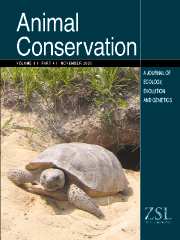Article contents
The need for pre-release health screening in animal translocations: a case study of the Cuban iguana (Cyclura nubila)
Published online by Cambridge University Press: 30 March 2001
Abstract
A serious concern with the increasing use of translocation and reintroduction in animal conservation programs is the potential for disease transmission between captive and free-ranging populations. As part of an experimental headstarting program, 45 juvenile Cuban iguanas, Cyclura nubila, were artificially incubated, maintained in captivity for six to 18 months, and subsequently released into natural areas on the US Naval Base at Guantánamo Bay, Cuba. Prior to release, all animals underwent physical examinations, hematological analyses, plasma biochemical determinations, and blood and fecal parasite screening. Comparable data were collected from free-ranging juveniles to establish normal baseline values. Although all hematological parameters were within expected ranges for healthy reptiles, captive juveniles exhibited higher total leukocyte counts and percent lymphocytes, but lower percent heterophils, than free-ranging juveniles. All biochemical values other than lactate dehydrogenase and creatine phosphokinase were within normal ranges. Although higher than reported in other species, these enzymes did not differ in captive and free-ranging juveniles. Free-ranging juveniles significantly exceeded captive juveniles in levels of potassium, alkaline phosphatase, lactate dehydrogenase, total protein, cholesterol and triglycerides, whereas the reverse was true for carbon dioxide and glucose. Although free-ranging juveniles exhibited oxyurids and coccidian oocysts in their feces, captive juveniles were negative for the presence of these parasites. Electron microscopy confirmed that a high percentage of both captive and free-ranging juveniles possessed erythrocytes infected with the piroplasm Sauroplasma. Implications of these results for successful repatriation of captive-reared iguanas are discussed.
- Type
- Research Article
- Information
- Copyright
- © 1998 The Zoological Society of London
- 14
- Cited by


